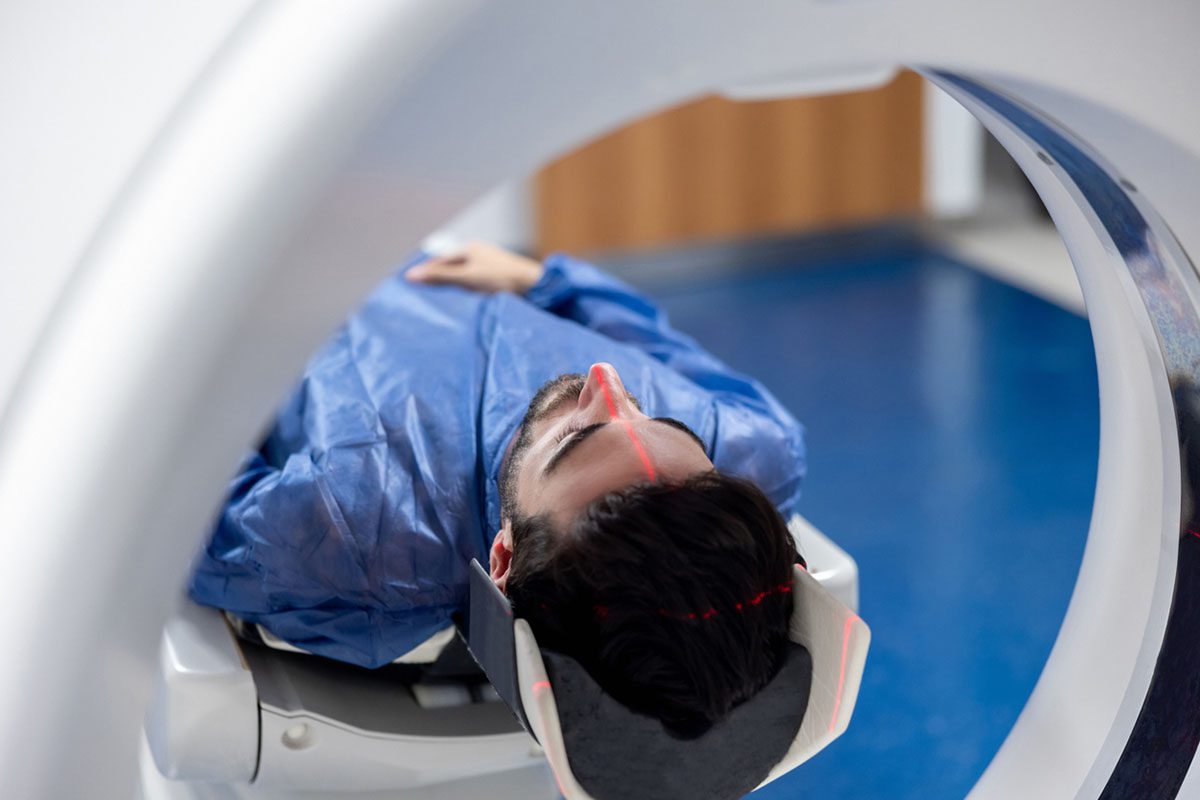
Prim Care Companion CNS Disord 2021;23(4):20l02745
To cite: Yeo K, Gupta M, Correll CU. Huntington’s disease with psychotic features. Prim Care Companion CNS Disord. 2021;23(4):20l02745.
To share: https://doi.org/10.4088/PCC.20l02745
© Copyright 2021 Physicians Postgraduate Press, Inc.
aUnited States Air Force, Eglin Air Force Base, Eglin, Florida
bClarion Psychiatric Center, Clarion, Pennsylvania
cDepartment of Psychiatry, The Zucker Hillside Hospital, Northwell Health, Glen Oaks, New York
dDepartment of Psychiatry and Molecular Medicine, Donald and Barbara Zucker School of Medicine at Hofstra/Northwell, Hempstead, New York
*Corresponding author: Mayank Gupta, MD, Clarion Psychiatric Center, 2 Hospital Drive, Clarion, PA 16214 ([email protected]).
Huntington’s disease (HD) is a progressive neurodegenerative disorder inheritable in an autosomal dominant fashion.1–6 It is characterized by a triad of choreiform movements, cognitive decline, and psychiatric disturbances.1–5 HD is caused by trinucleotide triplet (cytosine-adenine-guanine [CAG]) repeats in the Huntington gene on the short arm of chromosome 4p1.1,4,5,7 A healthy individual without HD has around 11–35 CAG repeats, whereas an HD patient has 36 or more.5
Onset of symptoms frequently occurs during the fourth decade of life4,5 but can appear earlier, especially if there is family history of HD. With each successive generation there is an expansion of the CAG repeat number, which causes an earlier and more severe phenotype. This phenomenon is termed genetic anticipation.1 HD follows a relentlessly progressive course that results in death, usually 15–20 years after disease onset.2
The hallmark of HD is its distinctive choreiform movements that are part of the motor presentation, which can include loss of coordination, dysphagia, and dysphasia.3 HD’s motor symptoms usually occur simultaneously with cognitive abnormalities that can include memory impairment, decreased executive functions, and decreased concentration.3
HD’s psychiatric manifestations encompass the full spectrum of psychiatric illness, including anxiety, depression, impulsivity and disinhibition, psychosis, and suicidal thoughts, and can cause significant morbidity.3,8 Suicide rates in HD patients may be 4–6 times higher than in the general population, being that it is the third most common cause of death in this population.3 Psychosis is less common in HD, between 3%–11%, and can potentially precede the motor manifestation of the disease9; this was the case for the patient presented here. Currently, there is no known cure for HD.10 Treatment is symptomatic and remains supportive.9
Case Report
The patient was a single, unemployed White man in his mid-40s who lived with family. He initially presented to the emergency department (ED) with complaints of “feeling sick.” The ED had never seen the patient prior to this encounter. The patient requested specifically to be tested for HIV and hepatitis. He reported being a former intravenous drug user and former daily drinker and was still a current daily smoker. He denied other medical or mental health issues or family history of any significant medical issues. He also denied being on any medication. Except for elevated aspartate aminotransferase (AST) of 77 U/L and alanine aminotransferase (ALT) of 139 U/L, his physical examination and laboratory values were unremarkable. No choreiform movements or neurologic abnormalities were noted. His HIV test came back negative. The ED discharged the patient with instructions for supportive care and follow-up with his primary care physician. The patient’s hepatitis panel came back positive for hepatitis C the next day, of which he was informed.
After this initial encounter, the patient visited the same ED 7 more times. Some of these visits were only spaced 1 day apart. He presented with different complaints each time, including chest pain, syncope, sore throat, dysphagia, and stroke concerns. A complete workup for his complaints was performed at each visit, including electrocardiogram, troponin, chest x-ray, D-dimer, and computed tomography scan of the head, along with appropriate laboratory tests. Except for mild elevation of liver enzymes, all imaging and laboratory results were unremarkable. Drug and alcohol screens were negative. On 1 occasion, ceruloplasmin and serum copper level were tested to rule out Wilson’s disease; the results came back within normal limits. His physical examination was within normal limits. Again, no choreiform movements or neurologic abnormalities were noted. He did appear more agitated and anxious at times. Occasionally, he would also be uncooperative during physical examination. During each of these visits, the patient was reassured and discharged with instructions to follow up with his primary care physician.
A month after the last ED visit, the patient again arrived at the ED, this time under involuntary commitment via police escort for “bizarre behavior.” The patient had been calling 911 during the past few weeks asking for medical attention but then would refuse to come to the ED when the ambulance arrived. The ED staff was unable to obtain a medical history from the patient as he was mute. History was provided by the patient’s father over the telephone: he had not been caring for himself, had not been showering, and had paucity of speech. It was also learned that the patient’s mother had died of some disease in her late 50s. However, he could not remember the name of the disease.
On physical examination, the patient’s condition had markedly changed. He now had observable choreic movements of the upper extremities, right worse than left. He also had multiple lesions on both hands, some with scabs and some with healing wounds. His lower extremities had ulcers and showed poor hygiene. The ED provider tested the patient’s ammonia level to rule out hepatic encephalopathy; the result was normal. Given his history of hepatitis C, venereal disease research laboratory test and rapid plasma reagin test were also ordered to rule out neurosyphilis; these results came back negative as well. The patient was admitted to an out-of-town psychiatric facility, the medical records of which are presently inaccessible to the authors. What is known is that the patient was treated for an unknown number of days in an inpatient psychiatric ward and discharged on an unknown anxiolytic with instructions for outpatient follow-up.
After a few weeks of being discharged and returned to his hometown, the patient was once again brought to the ED via ambulance and police escort under an involuntary commitment warrant. This time, the patient was reportedly walking around his neighborhood in the middle of winter (the temperature was 30°F [−1°C]) wearing only a pair of shorts, no shirt and no shoes. The patient had been knocking on people’s door asking for money. When asked what was going on, he stated he “just needed to calm down.” On examination, he appeared disheveled and was noticeably restless. He exhibited involuntary choreiform movements of both upper and lower extremities. He reported hearing demons’ voices telling him he was going to hell. There were no visual hallucinations. He had multiple lacerations and scabbing on both feet, although no infections were noted. The only abnormal laboratory values were elevated liver enzymes: AST of 75 U/L and ALT of 127 U/L. The urine drug screen was negative. The initial diagnosis was schizophreniform disorder with Huntington chorea, and he was admitted to our psychiatric inpatient unit with initiation of by-mouth quetiapine extended-release (ER) 25 mg 3 times/day to control his psychotic symptoms along with haloperidol 5 mg and lorazepam 2 mg every 4 hours as needed for agitation.
While in the psychiatric ward, the patient had multiple issues and concerns that presented a unique challenge. His ongoing auditory hallucinations eventually had a command component to them wherein he was told to harm the staff and inmates, though he denied any intentions of doing so and wished to be locked up and isolated so he could not hurt others. He had choreiform movements involving the upper and lower extremities. He also started exhibiting a swaying motion of the torso. The patient would complain to the nurses of headache and pain in his back, knees, and ankles, requesting pain medications.
Neurology consultation was made early on during the patient’s stay in the psychiatric ward. It was learned that the neurologist had seen the patient’s mother in the past for HD. Based on that information and the patient’s current presentation, the diagnosis of HD was confirmed. We did not have access to the neurologist’s medical records, which included genetic testing and brain magnetic resonance imaging, electroencephalography, and spinal tap results.
It took about 2 months before the medical team was able to arrive at a treatment regimen that stabilized the patient. His stability was measured based on several factors: his participation with group activities, a decrease in request for as-needed pain medications, his choreiform movements, his complaints of psychosis and auditory hallucinations, and presence of adverse effects from medications.
The patient was started on quetiapine ER 25 mg 3 times/day, titrated up to 500 mg 2 times/day, along with diazepam 5 mg 3 times/day. Quetiapine was selected for its antipsychotic properties and ability to improve chorea.11 It also has a low extrapyramidal symptom profile. Diazepam was used to help with the patient’s anxiety symptoms. This combination worked well at first, but we later found that that quetiapine was too sedating and caused the patient to have transaminitis wherein his AST level trended up to > 140 U/L and his ALT to > 320 U/L. Quetiapine was replaced with clozapine. This substitution did not yield the efficacy we hoped for. Moreover, it was causing the patient to experience sialorrhea that was intolerable. It was replaced with olanzapine, titrated up to 15 mg/day. This olanzapine dose proved to be useful in managing the patient’s psychosis and chorea. Fortunately, it did not cause transaminitis or sialorrhea for the patient.
At one point, electroconvulsive therapy (ECT) was also considered as a possible treatment modality for the patient’s HD-associated psychosis, as there are a handful of case studies12,13 that seem to show efficacy. Unlike quetiapine (and olanzapine), ECT does not have transaminitis in its side effect profile and is generally safe. However, as is the case in many other medical institutions,14 ECT was not available at our facility, and if this treatment modality were to be pursued, the patient would need to be transported to a different city where ECT was available.
Discussion
This case describes a patient who initially presented to the ED with what appeared to be anxiety and hypochondria. He had a total of 8 ED visits in 4 months before the onset of obvious psychotic symptoms (being mute, not dressing appropriately, hearing voices). Per ED notes, there were no recorded motor disturbances or neurologic findings during the initial 8 visits.
Recognizing HD can be challenging, as it can manifest as any single one of its various motor, cognitive, or psychiatric symptoms or a combination of them. It can be difficult to recognize HD even by a psychiatrist.6 There are numerous case reports2–6,9 on HD, and each presentation is unique, which illustrates the importance of obtaining a thorough history and having a wide differential diagnosis when encountering a patient in his/her 40s who exhibits motor, cognitive, or psychiatric symptoms. If and when a patient appears to be a poor historian, it may be beneficial to obtain the history from family members, as seen in this case. Once identified, the patient should be closely followed. Although the course of HD cannot be altered, early intervention can help alleviate symptoms, lessen disease burden, and prevent harm. For instance, medications such as tetrabenazine can be given to diminish the effects of chorea, antipsychotic drugs like haloperidol can be given to help with psychosis, and patients and family members can be provided education and counseling to prepare them to better manage the disease course.
The patient in this case had a non–straightforward treatment course, and the treatment regimen he ended up with is rather different when compared to treatment plans of other case reports reviewed.2–6,9 For instance, 1 case report9 had a treatment regimen consisting of risperidone 0.5 mg twice/day, citalopram 20 mg once/day, and amantadine 200 mg once/day. Another had clozapine 300 mg once/day and amitriptyline 25 mg once/day.4 Also, it is common practice to use tetrabenazine as first-line treatment for management of chorea. In our scenario, tetrabenazine was not used because the patient’s chorea was mild and overall in good control with olanzapine alone. This finding highlights that there is no “one size fits all” in treating HD. Medication choices are largely empiric and based on case reports and clinical experiences.6,15
The medication side effect profiles and patients’ presenting symptoms are important factors in choosing pharmacologic agents. The patient in our case had hepatitis C, and this likely caused the elevated baseline transaminase level. Quetiapine caused his ALT and AST values to trend upward. When quetiapine was replaced with olanzapine, his transaminase values returned to baseline. He was also unable to tolerate the sedation effects of quetiapine or the hypersalivation effects of clozapine.
Conclusion
A high level of suspicion when encountering a middle-aged person with complaints of motor, cognitive, or psychiatric symptoms along with good family history can help correctly diagnose HD. Although there is no cure for HD, early identification can help with lessening the disease burden on the patient, family, and health care system. Medications such as tetrabenazine can be prescribed for chorea,10 and antipsychotic drugs such as haloperidol can be used for psychotic symptoms. Symptomatic management, however small, can improve the patient’s ability to cope and quality of life. Education and counseling can be provided to patients and their families so that they can be better equipped to manage the disease process.16 HD support groups online and locally can provide a place of comfort and support for patients and their families. It is a tragic event when HD patients, such as the one presented here, do not receive the right diagnosis, medication, and support—it adds unnecessary burden and cost to the family and health care system. In the end, the patient suffers the most.
Pharmacologic treatment should be tailored to the patient’s needs. Sometimes, a better-known first line of treatment may not be needed or used; in our case, the patient did not start or take tetrabenazine even though he had chorea, as it was generally mild and well controlled on olanzapine alone. Quetiapine provided good relief for his psychosis but was discontinued as it caused transaminitis most likely due to hepatitis C. Clozapine was discontinued and never brought to its full potential because it caused sialorrhea even at a low dose. All of these findings and the patient’s medical history play a role in designing the best treatment plan for those with HD.
Published online: August 5, 2021.
Author contributions: Dr Gupta conceptualized the report and was the treating physician. Dr Yeo was a major contributor in writing and searching the literature. Dr Correll worked on the revised version of the manuscript. All authors read and approved the final manuscript.
Potential conflicts of interest: Dr Correll has been a consultant and/or advisor to or has received honoraria from Acadia, Alkermes, Allergan, Angelini, Axsome, Gedeon Richter, Gerson Lehrman Group, Indivior, IntraCellular Therapies, Janssen/J&J, Karuna, LB Pharma, Lundbeck, MedAvante-ProPhase, MedInCell, Medscape, Merck, Mylan, Neurocrine, Noven, Otsuka, Pfizer, Recordati, Rovi, Servier, Sumitomo Dainippon, Sunovion, Supernus, Takeda, and Teva; has provided expert testimony for Janssen and Otsuka; has served on a Data Safety Monitoring Board for Lundbeck, Rovi, Supernus, and Teva; and has received grant support from Janssen and Takeda. He is also a stock option holder of LB Pharma. Drs Yeo and Gupta report no conflicts of interest related to the subject of this report.
Funding/support: None.
Additional information: Information has been de-identified to protect anonymity.
References (16)

- Suchowersky O. Huntington’s disease: Clinical Features and Diagnosis. UpToDate. Updated December 21, 2017. Accessed June 8, 2021. https://www.uptodate.com/contents/huntington-disease-clinical-features-and-diagnosis?search=huntington-disease-clinical-features-and%20diagnosis&source=search_result&selectedTitle=1~47&usage_type=default&display_rank=1#H3
- Cankurtaran ES, Ozalp E, Soygur H, et al. Clinical experience with risperidone and memantine in the treatment of Huntington’s disease. J Natl Med Assoc. 2006;98(8):1353–1355. PubMed
- Jauhar S, Ritchie S. Psychiatric and behavioral manifestations of Huntington’s disease. Adv Psychiatr Treat. 2010;16(3):168–175. CrossRef
- Sengul CB, Hanci E. A case of Huntington’s disease presenting with psychotic features. J Psychiatry Neurolog Sci. 2014;27:250–253.
- Xu C, Yogaratnam J, Tan N, et al. Psychosis, treatment emergent extrapyramidal events, and subsequent onset of Huntington’s disease: a case report and review of the literature. Clin Psychopharmacol Neurosci. 2016;14(3):302–304. PubMed CrossRef
- Scher LM, Kocsis B. How to target psychiatric symptoms of Huntington’s disease. Curr Psychiatr. 2012;11(9):34–39.
- Corrêa BB, Xavier M, Guimarães J. Association of Huntington’s disease and schizophrenia-like psychosis in a Huntington’s disease pedigree. Clin Pract Epidemiol Ment Health. 2006;2(1):1. PubMed CrossRef
- Huntington’s Disease. Mayo Clinic. Updated June 13, 2017. Accessed June 8, 2021. https://www.mayoclinic.org/diseases-conditions/huntingtons-disease/symptoms-causes/syc-20356117
- Ding J, Gadit AM. Psychosis with Huntington’s disease: role of antipsychotic medications. BMJ Case Rep. 2014;2014:bcr2013202625. PubMed CrossRef
- Reinberg S. New Drug Eases Huntington’s Disease Symptoms. WebMD. Accessed June 8, 2021. https://www.webmd.com/brain/news/20160707/new-drug-eases-huntingtons-disease-symptoms-study#2
- Sharon I, Sharon R, Wilkens JP, et al. Huntington Disease Dementia Medication. MedScape. Updated December 5, 2016. Accessed June 8, 2021. https://emedicine.medscape.com/article/289706-medication
- Strassler D. Psychiatric Symptoms in Huntington Disease may Benefit from ECT. PsychiatryAdvisor. Updated May 22, 2017. Accessed June 8, 2021. Psychiatric Symptoms in Huntington Disease May Benefit From ECT - Psychiatry Advisor
- Shokrgozar S, Abdollahi E, Khani F, et al. Effectiveness of ECT in Huntington’s disease with mood and psychotic symptoms: a case report. Der Pharmacia Lettre. Accessed June 8, 2021. https://www.scholarsresearchlibrary.com/articles/effectiveness-of-ect-in-huntingtons-disease-with-mood-and-psychotic-symptoms-a-case-report.pdf
- Case BG, Bertollo DN, Laska EM, et al. Declining use of electroconvulsive therapy in US general hospitals. Biol Psychiatry. 2012. PubMed
- Suchowersky O. Huntington disease: Management. UpToDate. Updated December 21, 2017. Accessed June 8, 2021. https://www.uptodate.com/contents/huntington-disease-management?search=huntington%20management&source=search_result&selectedTitle=1~54&usage_type=default&display_rank=1
- For Physicians: Stages of HD Progression. UC San Diego School of Medicine. Accessed June 8, 2021. https://medschool.ucsd.edu/som/neurosciences/centers/huntingtons-disease/professionals/Pages/stages-of-progression.aspx
Please sign in or purchase this PDF for $40.




